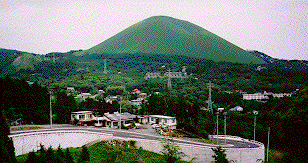 Photo 1 Omuroyama scoria cone.
Photo 1 Omuroyama scoria cone.
Geology and eruptive history of the Higashi Izu monogenetic volcano field (Izu Tobu Volcano Field), Japan
Higashi Izu monogenetic volcano field (HIMVF) is located in the Izu Peninsula, which is on the northern tip of the Izu-Bonin volcanic arc (Fig. 1). The HIMVF is composed of over 60 terrestrial small monogenetic volcanoes, which are distributed over the area of 350 km^2 in the eastern part of the Izu Peninsula (Fig. 2). Besides these, the western half of the Higashi-Izu-oki submarine volcanoes, distributed off the east coast of the Izu Peninsula, can be regarded as a submarine equivalent of the HIMVF because of their similar petrology.
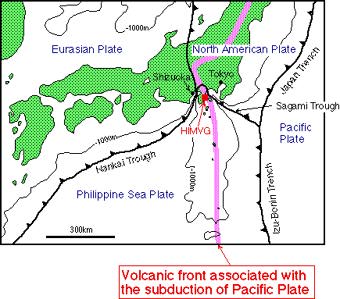 Fig. 1 Locality and tectonic situation of the Higashi Izu monogenetic volcano field.
Fig. 1 Locality and tectonic situation of the Higashi Izu monogenetic volcano field.
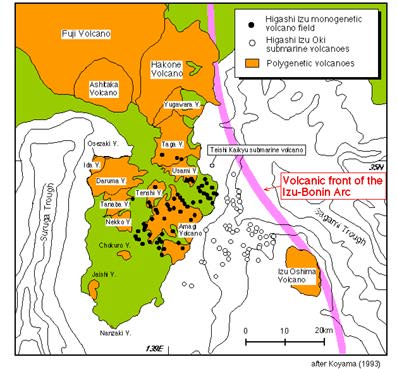 Fig. 2 Locality and spatial distribution of the Higashi Izu monogenetic volcano field and other Quaternary volcanoes in and around the Izu Peninsula (Koyama, 1993). The depth contour interval is 500 m.
Fig. 2 Locality and spatial distribution of the Higashi Izu monogenetic volcano field and other Quaternary volcanoes in and around the Izu Peninsula (Koyama, 1993). The depth contour interval is 500 m.
The HIMVF is composed of scoria/spatter cones, tuff rings, maars, and lava domes, many of which accompany lava flows and/or scoriaceous pyroclastic fall deposits (Fig. 3, Photo 2). Only the Kawagodaira volcano has pyroclastic flows and plinian pumice fall deposits. All of the HIMVF volcanoes are monogenetic and have no evidence for significant dormancy during each eruption. Because of the monogeneity, one tephra layer of the HIMVF strictly corresponds to one HIMVF volcano.
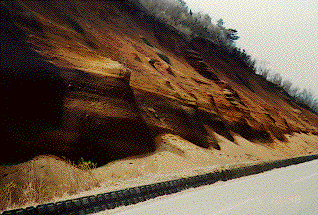 Photo 2 Stratified scoria exposed at Sukumoyama scoria cone.
Photo 2 Stratified scoria exposed at Sukumoyama scoria cone.
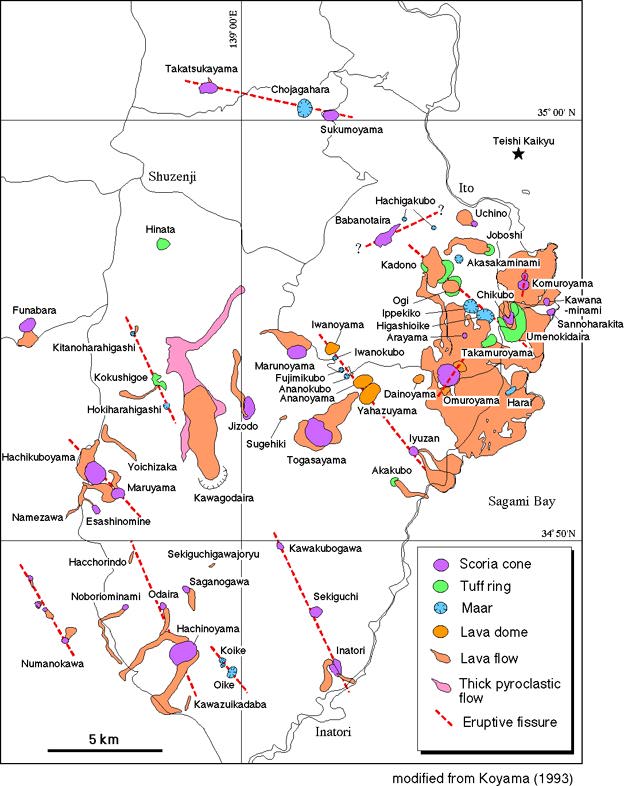 Fig. 3 Geological map of the Higashi Izu monogenetic volcano field (Koyama, 1993).
Fig. 3 Geological map of the Higashi Izu monogenetic volcano field (Koyama, 1993).
The detailed eruptive history of the HIMVF was recently revealed by tephrochronology and loesschronometry, additionally using available 14C ages (Hayakawa and Koyama, 1992; Koyama et al., 1995). Stratigraphy and chronology of the HIMVF are summarized in Fig. 4. Stratigraphic horizons of each HIMVF volcano and each tephra of outside origin, are schematically shown in this figure. Of all the 62 volcanoes of the HIMVF, the ages of 52 volcanoes were estimated. Multiple names in one box (e.g., seven volcanoes along the Iwanoyama-Iyuzan fissure at 2.7 ka) shows that these volcanoes probably erupted along a single fissure simultaneously.
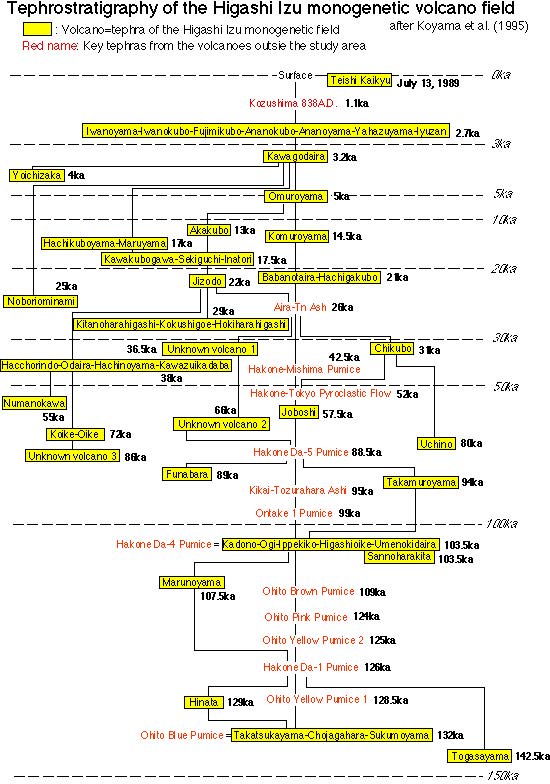 Fig. 4 Summary of the stratigraphy and chronology of the Higashi Izu monogenetic volcano field (HIMVF) and associated widespread tephras (Koyama et al., 1995). Box shows the horizon of each vent of the HIMVF.Ellipse shows the horizon of widespread tephras from the outside of the study area. Stratigraphic relationship observed in an outcrop is shown with a solid line. Two widespread tephra, Hakone Da-4 Pumice and Ohito Blue Pumice, is interbedded within the Ippekiko/Umenokidaira and Takatsukayama tephras, respectively, meaning that they erupted simultaneously.
Fig. 4 Summary of the stratigraphy and chronology of the Higashi Izu monogenetic volcano field (HIMVF) and associated widespread tephras (Koyama et al., 1995). Box shows the horizon of each vent of the HIMVF.Ellipse shows the horizon of widespread tephras from the outside of the study area. Stratigraphic relationship observed in an outcrop is shown with a solid line. Two widespread tephra, Hakone Da-4 Pumice and Ohito Blue Pumice, is interbedded within the Ippekiko/Umenokidaira and Takatsukayama tephras, respectively, meaning that they erupted simultaneously.
Figure 5 shows the spatial and temporal distribution of the 52 HIMVF volcanoes in Fig. 4. This figure suggests that vent locations of the volcano field were limited to the northern half of the present distribution during 80-150 ka and were expanded to the whole field in the later stage. Figure 5 shows that several volcanoes lying on a single NW-SE alignment were active simultaneously.
The location of the Teishi Knoll volcano and the epicenters of the earthquakes associated with the 1989 eruption are distributed along a line with an NW-SE trend. Although this line does not correspond to any vent alignment of the HIMVF, many geophysical and geodetic studies suggest the magma intrusion along this line. Thus, the line along the microearthquake epicenters and the Teishi Knoll can be regarded as an equivalent of the vent alignments of the HIMVF.
The NW-SE trends of alignments of eruptive fissures are well concordant with the trends of maximum horizontal compressional axes of regional crustal stress in the eastern Izu Peninsula
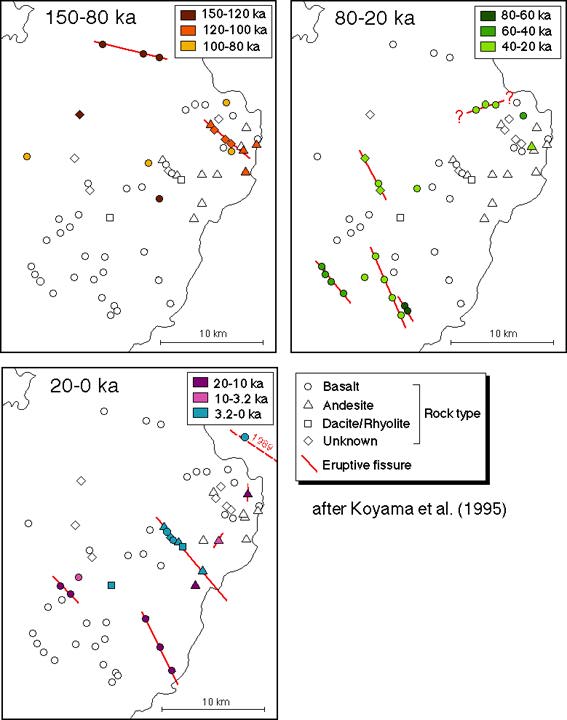 Fig. 5 Spatial and temporal distribution of vents of the Higashi Izu monogenetic volcano field (Koyama et al., 1995). Rock types are after Hamuro (1985). Thick lines show possible vent alignments in each period.
Fig. 5 Spatial and temporal distribution of vents of the Higashi Izu monogenetic volcano field (Koyama et al., 1995). Rock types are after Hamuro (1985). Thick lines show possible vent alignments in each period.
According to the previous petrological studies, the volcanic rocks of the HIMVF are composed of basalt-basaltic andesite (SiO2 = 49-60 wt%) and dacite-rhyolite (SiO2 = 68-74 wt%), showing a bimodal distribution of SiO2 compositon. Andesitic rocks often include tonalitic xenoliths or xenocrysts, and sometimes yield basaltic inclusions or olivine xenocrysts. Petrologic characteristics of these rocks show that the dacitic-rhyolitic magma of the HIMVF originated from the melting of the tonalitic upper crust, and that the andesitic magma was formed by fractional crystallization or by assimilation with the tonalitic upper crust.
The magma discharge volume of each volcano is mostly less than 4 x 10^11 kg, except for the Kawagodaira, Omuroyama, Komuroyama, Hacchorindo-Kawazuikadaba, Kadono-Umenokidaira, and Takatsukayama-Sukumoyama volcanoes, each of which has a discharge volume of 4-10 x 10^11 kg.
Figure 6 shows the temporal variation of magma discharge volume of the HIMVF. The total magma discharge rate of the HIMVF seems to have rapidly increased since 40 ka. Four of the six largest eruptions (> 4 x 10^11 kg) occurred in the latest stage (0-40 ka). Andesitic and dacitic-rhyolitic activities are particulary dominant for the last 15 ka. No dacitic-rhyolitic activity existed before the eruption of the Kawagodaira volcano at 3.2 ka (Photo 3).
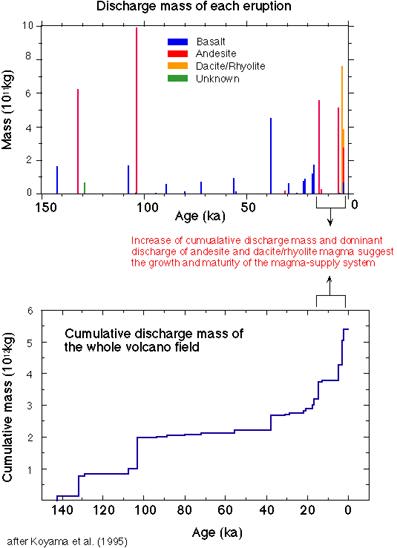 Fig. 6 Temporal variations of magma discharge mass of the Higashi Izu monogenetic volcano field (Koyama et al., 1995). Upper: discharge mass and rock type of each eruption. Rock types are after Hamura (1985). Lower: temporal changes of cumulative discharge of magma.
Fig. 6 Temporal variations of magma discharge mass of the Higashi Izu monogenetic volcano field (Koyama et al., 1995). Upper: discharge mass and rock type of each eruption. Rock types are after Hamura (1985). Lower: temporal changes of cumulative discharge of magma.
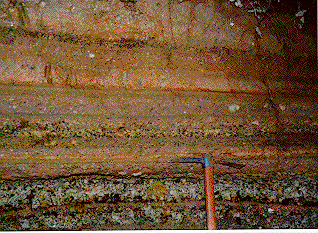 Photo 3 Pumice and ash layers erupted from Kawagodaira Volcano.
Photo 3 Pumice and ash layers erupted from Kawagodaira Volcano.
Andesitic and dacitic-rhyolitic volcanoes of the HIMVF are limited to the central part of the whole distribution of the HIMVF and the submarine equivalent, while many of the basaltic volcanoes exist in the outer zone, forming a concentric zonal distribution of SiO2 composition (Fig. 7). Similar concentric zonal patterns exist in modal abundance of xenocrysts, in assemblages of phenocrysts and groundmass minerals, and in chemical compositions of olivine and spinel. All these concentric zonal distributions can be explained by melting of the tonalitic upper crust and its assimilation with a parent magma in the central part of the concentric zoning. Spatial distribution of magma discharge volume shows that four of the six largest eruptions (> 4 x 10^11 kg) are located in the inner part of the concentric zonation.
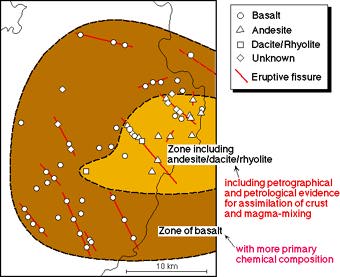 Fig.7 Rock type of each vent of the Higashi Izu monogenetic volcano field. Rock types and their concentric zonation are after Hamuro (1985). Vent and fissure locations are after Koyama et al. (1995).
Fig.7 Rock type of each vent of the Higashi Izu monogenetic volcano field. Rock types and their concentric zonation are after Hamuro (1985). Vent and fissure locations are after Koyama et al. (1995).
Selected references on the Higashi Izu monogenetic volcano field (not completed)
Geology and eruptive history
- Aramaki, S. and K. Hamuro, Geology of the Higasi-Izu monogenetic volcano group, Bull. Earthq. Res. Inst., Univ. Tokyo, 52, 235-278, 1977 (in Japanese with English abstract).
- Hamuro, K., Geology of Omuroyama volcano group, J. Geol. Soc. Japan, 84, 433-444, 1978 (in Japanese with English abstract).
- Hayakawa, Y., and Koyama, M., Eruptive history of the Higashi Izu monogenetic volcano field 1: 0-32 ka. Bull. Volcanol. Soc. Japan, 37, 167-181, 1992 (in Japanese with English abstract).
- Koyama, M., Geologic history of the Izu Peninsula and Quaternary deformations of the Ashigara and Oiso areas, The Earth Monthly, 8, 743-752, 1986 (in Japanese).
- Koyama, M., Volcanism and tectonics of the Izu Peninsula, Japan. Kagaku (Science), 63, 312-321, 1993 (in Japanese).
- Koyama, M., Hayakawa, Y., and Arai, F., Eruptive history of the Higashi-Izu monogenetic volcano field 2: mainly on volcanoes older than 32,000 years ago. Bull. Volcanol. Soc. Japan, 40, 191-209, 1995 (in Japanese with English abstract).
- Kuno, H., Geology and petrology of Omuroyama volcano group, north Izu, J. Fac. Sci., Univ. Tokyo, sec. 2, 9, 241-265, 1954.
Petrology
- Hamuro, K., Petrology of the Higashi-Izu monogenetic volcano group, Bull. Earthq. Res. Inst., Univ. Tokyo, 60, 335-400, 1985.
- Hamuro, K., S. Aramaki, H. Kagami, and K. Fujioka, The Higashi-Izu-oki submarine volcanoes. Part 1, Bull. Earthq. Res. Inst., Univ. Tokyo, 55, 259-297, 1980 (in Japanese with English abstract).
- Hamuro, K., S. Aramaki, K. Fujioka, T. Ishii, T. Tanaka, and K. Uto, The Higashi Izu-oki submarine volcanoes, Part 2, and the submarine volcanoes near the Izu Shoto Islands, Bull. Earthq. Res. Inst., Univ. Tokyo, 58, 527-557, 1983 (in Japanese with English abstract).
- Miyajima, H., Petrology of Higashi-Izu monogenetic volcano group -implication of xenocrysts, time and spacial variation of ejecta, J. Mineral. Petrol. Econ. Geol., 85, 315-336, 1990 (in Japanese with English abstract).
- Umino, S., M. Kato, and M. Koyama, Diversity of parent magmas of Higashi-Izu monogenetic volcano group. J. Phys. Earth, 39, 371-389, 1991.
Tectonic background
- Ida, Y., Interpretation of seismic and volcanic activities in the Izu block in relation to collision tectonics, J. Phys. Earth, 39, 421-440, 1991.
- Koyama, M., Volcanism and tectonics of the Izu Peninsula, Japan. Kagaku (Science), 63, 312-321, 1993 (in Japanese).
- Koyama, M., Late Quaternary-present tectonics in the northernmost area of the Izu-Bonin volcanic arc. J. Geogr., 103, 576-590, 1994 (in Japanese with English abstract).
- Koyama, M., and Umino, S., Why does the Higashi-Izu monogenetic volcano group exist in the Izu Peninsula? Relationships between late Quaternary volcanism and tectonics in the northern tip of the Izu-Bonin arc. J. Phys. Earth, 39, 391-420, 1991.
- Ukawa, M., Collision and fan-shaped compressional stress pattern around the Izu block at the northern edge of the Philippine Sea plate, J. Geophys. Res., 96, 713-728, 1991.
1989 eruption and associated phenomena
- Hori, S., Recent swarm activity around the Izu Peninsula, Rep. NRCDP, 43, 127-167, 1989 (in Japanese with English abstract).
- Ishii, H., Recent abnormal uplift on the Izu Peninsula (1980-1988), Bull. Earthq. Res. Inst., Univ. Tokyo, 64, 313-324, 1989 (in Japanese with English abstract).
- Okada, Y. and E. Yamamoto, A model for the 1989 seismo-volcanic activity off Ito, central Japan, derived from crustal movement data, J. Phys. Earth, 39, 1991.
- Oshima, S., M. Tsuchide, S. Kato, S. Okubo, K. Watanabe, K. Kudo, and J. Ossaka, Birth of a submarine volcano "Teishi Knoll", J. Phys. Earth, 39, 1991.
- Soya, T., K. Uto, T. Yamamoto, S. Sudo, S. Togashi, S. Nakano, K. Sakaguchi, K. Kikkawa, K. Mizuno, A. Takada, and K. Ono, Submarine eruption and products of the July1989 off the eastern Izu Peninsula, Chishitsu News, 422, 14-26, 1989 (in Japanese).
- Tada, T. and M. Hashimoto, Anomalous crustal deformation in the northeastern Izu Peninsula and its tectonic significance -tension crack model-, J. Phys. Earth, 39, 1991.
Return to Masato Koyama's Homepage








